The DIY ball mill market is estimated to be valued at USD 1902.8 million in 2025 and is projected to reach USD 3070.1 million by 2035, registering a compound annual growth rate (CAGR) of 4.9% over the forecast period.
The market demonstrates robust expansion driven by increasing hobbyist interest in mineral processing, ceramic production, and specialty powder preparation applications where commercial grinding services prove cost-prohibitive or unavailable for small-scale operations. Home workshop enthusiasts adopt ball mill technology for creating custom pigments, processing ceramic glazes, and preparing mineral specimens that require precise particle size reduction beyond conventional crushing methods. The equipment's versatility enables amateur geologists, artists, and craftspeople to achieve professional-grade powder consistency without investing in large-scale commercial grinding facilities.
Hobby ceramics markets represent a significant consumption segment where DIY ball mills enable artists to process raw clay materials, create custom glaze formulations, and recycle ceramic waste into usable powder form. Studio potters utilize compact ball mill systems for preparing specialty glazes that require specific particle size distributions and thorough mixing of colorant materials that cannot be achieved through manual blending methods. Educational institutions implement DIY ball mill projects in geology and materials science curricula where students learn mineral processing principles through hands-on equipment construction and operation experiences.
Supply chain dynamics reflect specialization among component suppliers who provide motors, bearings, jar materials, and grinding media specifically sized for DIY applications rather than industrial requirements. Hardware retailers expand inventory to include ball mill construction materials as hobbyist demand increases for quality components that ensure reliable operation and safety during extended grinding cycles. Online marketplaces facilitate access to specialized components including ceramic grinding jars, steel grinding balls, and variable speed motor controllers that enable precise operation optimization for different material types.
Safety considerations drive market development toward enclosed grinding systems with proper ventilation, dust collection, and remote monitoring capabilities that address health concerns associated with fine particle generation during grinding operations. Educational resources accompany equipment sales as manufacturers recognize the importance of proper operation training for users unfamiliar with grinding equipment safety protocols. Liability concerns influence product design toward fail-safe mechanisms and comprehensive instruction materials that reduce accident risks during equipment operation and maintenance.
Technology advancement focuses on noise reduction features and vibration dampening systems that enable operation in residential environments without disturbing neighbors or violating local noise ordinances. Smart control systems provide automatic operation cycles, temperature monitoring, and remote shutdown capabilities that allow unattended operation while maintaining safety oversight. Modular designs enable capacity expansion and component upgrades that accommodate changing processing requirements without complete equipment replacement.

| Metric | Value |
|---|---|
| DIY Ball Mill Market Estimated Value in (2025 E) | USD 1902.8 million |
| DIY Ball Mill Market Forecast Value in (2035 F) | USD 3070.1 million |
| Forecast CAGR (2025 to 2035) | 4.9% |
The DIY ball mill market is experiencing steady expansion due to growing interest from hobbyists, researchers, and small scale industries seeking cost effective grinding and mixing solutions. Rising demand in metallurgy, ceramics, electronics, and material science has increased the adoption of compact and user friendly ball mills for experimentation and small batch production.
Accessibility of affordable components, advancements in motor efficiency, and availability of modular designs have further supported market penetration. Online platforms have enhanced consumer reach by providing convenient access to product variations, tutorials, and spare parts, enabling a wider user base to adopt DIY ball mills.
The outlook remains positive as increasing awareness around material customization and scientific exploration continues to support demand from educational institutions, laboratories, and enthusiasts.
The market is segmented by Type of Mill, Application, and Sales Channel and region. By Type of Mill, the market is divided into Planetary Mills, Ball Mills, and Attritor Mills. In terms of Application, the market is classified into Metallurgy, Pharmaceuticals, Cosmetics, and Food Processing. Based on Sales Channel, the market is segmented into Online and Offline. Regionally, the market is classified into North America, Latin America, Western Europe, Eastern Europe, Balkan & Baltic Countries, Russia & Belarus, Central Asia, East Asia, South Asia & Pacific, and the Middle East & Africa.

The planetary mills segment is projected to contribute 54.60% of total revenue within the type category, positioning it as the leading segment. Growth is being driven by its high efficiency in grinding, uniform particle size distribution, and versatility in handling a wide variety of materials.
Planetary mills are valued for their ability to deliver precise results in both dry and wet grinding conditions, making them popular among users who require reliable and reproducible outcomes. Their compact structure, adaptability for laboratory and DIY purposes, and capability to handle multiple samples simultaneously have enhanced their dominance.
This blend of performance and efficiency has solidified planetary mills as the preferred choice in the type category.

The metallurgy application segment is expected to hold 48.20% of the market by 2025, emerging as the most prominent application. This growth is being fueled by increasing demand for efficient grinding and blending processes in metal refining, alloy preparation, and powder metallurgy.
DIY ball mills are widely adopted in metallurgy due to their ability to process diverse metals and alloys into fine powders suitable for further applications. The emphasis on cost effective and customizable equipment has led to higher usage in small scale and experimental metallurgy projects.
Consistent demand for metallurgical innovations and material optimization has reinforced the application segment’s leadership within the market.
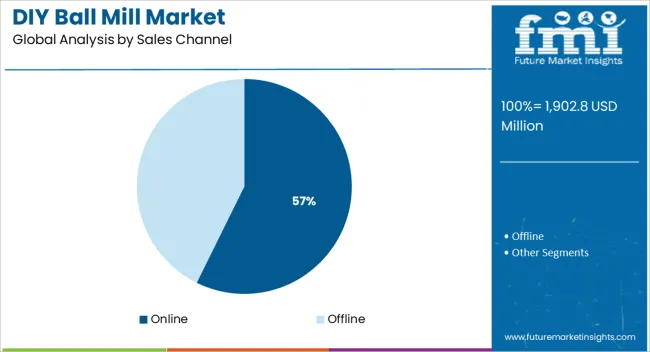
The online sales channel is anticipated to represent 57.30% of the market, making it the leading distribution method. This share is attributed to the rising popularity of e commerce platforms that provide easy access to a variety of DIY ball mill components and kits.
Online availability has enabled customers to compare products, read reviews, and access instructional content, significantly improving purchasing decisions. The convenience of global reach, wider product visibility, and cost competitiveness has further strengthened online dominance.
With increasing digital adoption and preference for direct-to-consumer channels, online platforms continue to be the primary growth driver in the distribution landscape for DIY ball mills.
The global market for DIY ball mills reached a valuation of USD 1,648.4 million in 2025 from USD 1,325.6 million in 2020. The observed CAGR during the historical period (2020 to 2025) was 5.6%, and this growth was mainly driven by the increasing popularity of home brewing and rapid adoption of the DIY culture among gen z and millennials.
There is a wide range of factors driving growth in the global DIY ball mill market. The increasing popularity of home brewing is estimated to be one of the leading factors behind the growth. Home brewing is considered to be a primary hobby that has seen renewed interest in recent years, thanks to the rise of the craft beer industry. The immense popularity and availability of home brewing kits is another crucial factor that has eventually led to increasing demand for DIY ball mills, as they are necessary for crushing malt grains into powder form.
A wide range of influential factors has been evaluated to stir the soup in the DIY ball mill industry. Analysts at Future Market Insights have analyzed the restraining elements, lucrative opportunities, and upcoming threats that can pose a challenge to the progression of the market for DIY ball mills.
The drivers, restraints, opportunities, and threats identified are as follows:
DRIVERS
RESTRAINTS
OPPORTUNITIES
THREATS
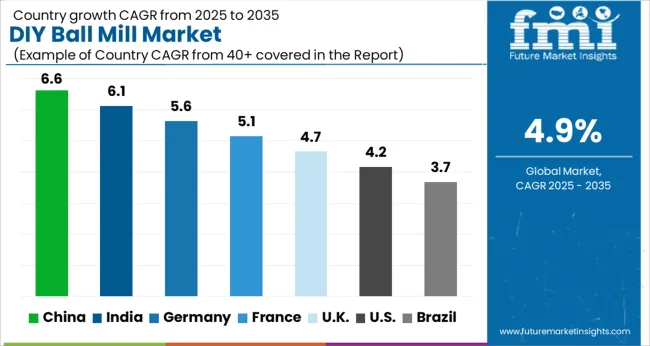
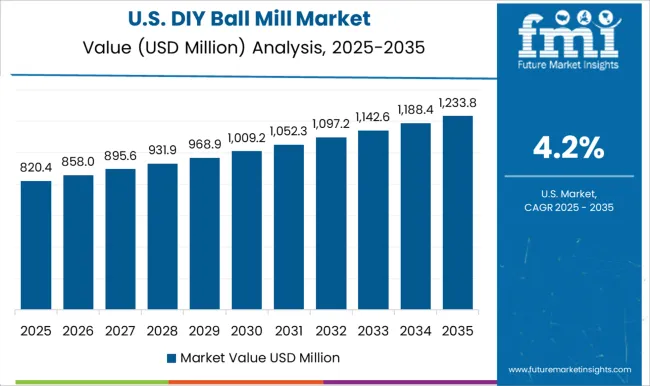
Adoption of Grinding Mills to Surge among Hobbyists in the USA for Developing Metalworking Projects
The USA DIY ball mill market is estimated to hold 69.8% of the share across North America, says Future Market Insights. The DIY ball mill market is developing rapidly across the USA. Hobbyists and amateur machinists in the country are increasingly turning to ball mills as a way to create their own unique metalworking projects.
There are numerous reasons for the high popularity of DIY ball mills in the USA. The first is that they are relatively simple to build from scratch. Secondly, ball mills can be used to create a wide variety of metalworking projects, right from small parts to large sculptures. Lastly, ball mills are relatively inexpensive, making them a great option for hobbyists and amateurs alike.
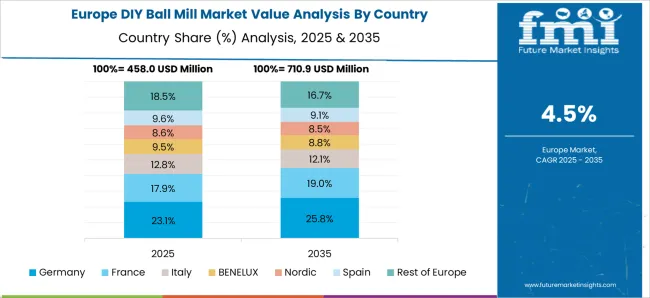
Demand for Grinding Equipment to Catapult in Germany and the United Kingdom as Popularity of DIY Tutorials Surges
The DIY ball mill market in Europe is set to escalate rapidly as consumers look for new ways to cut costs and take on home improvement projects themselves. The popularity of DIY TV shows and online tutorials has made DIY projects more accessible than ever before across Germany and the United Kingdom. Owing to the aforementioned factors, Germany is estimated to hold 26.6% of the Europe market share in 2025, while the United Kingdom is projected to expand at a CAGR of 6.4% over the estimated period (2025 to 2035).
The trend for Home Brewing of Beer to Boost Sales of Planetary Ball Mills across India and China
The market for DIY ball mills is likely to surge at a fast pace in the Asia Pacific. This growth is attributed to the rising popularity of home brewing and the need for cost-effective ways to make high-quality beer.
Ball mills are an essential piece of equipment for several home brewers, and they can be used to create a wide variety of beers. The market for DIY ball mills is expected to be bolstered in the next ten years as millennials begin to appreciate the benefits of home brewing across India and China.
India and China are the market leaders in Asia Pacific, and their most recent CAGRs in the DIY ball mill market are 6.7% and 6.6%, respectively. Japan contributes to around 4.1% of the overall market share.
The ability of Benchtop Ball Mills to Reduce the size of Difficult-to-grind Food Ingredients Will Aid the Demand
A ball mill is a type of grinder that is extensively used to grind and reduce the size of extracted materials such as rocks and glass. The ability of DIY ball mills to lower the size of difficult-to-grind materials such as food products, ceramics, and ores makes them a crucial piece of machinery for the food processing sector.
A typical DIY ball mill can be used to process a wide range of food products in both domestic and professional settings. For processing orders with a high volume, such as those from the food processing industry, commercial ball mills are frequently employed.
Demand for Mini Ball Mills to Surge Exponentially among Cosmetics Manufacturers
Based on application, the cosmetics segment is anticipated to remain at the forefront during the forecast period, finds Future Market Insights. DIY ball mills are considered to be cylindrical device that is used to grind and reduce the size of materials such as ores, as well as raw materials for ceramics, chemicals, and paints.
These devices include both raw materials and media such as ceramic balls. They rotate along a horizontal axis, and the material inside these mills is crushed into incredibly little bits when it is turned. The cosmetics industry frequently employs this method to produce pigments and powdered makeup. Getting an ultra-fine powder is crucial for producing a smooth high-end product, as consumers might expect. Ball mills are perfect for this task because they may be used to pulverize almost anything.
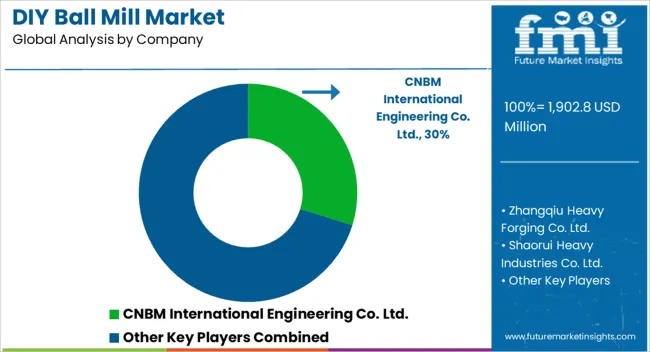
The DIY ball mill market is supported by a mix of industrial machinery producers and specialized manufacturers catering to small-scale material processing, laboratory research, and hobbyist applications. CNBM International Engineering Co. Ltd. leads the market with cost-effective and durable ball mill systems designed for both educational and pilot-scale projects. The company focuses on modular and easy-to-assemble designs that appeal to small manufacturers and research institutions. Zhangqiu Heavy Forging Co. Ltd. provides high-quality grinding media and forged steel balls, a critical component in DIY and small-scale milling operations, ensuring consistent particle size reduction and durability.
Shaorui Heavy Industries Co. Ltd. and Shanghai Minggong Heavy Equipment Co. Ltd. supply compact, customizable milling systems derived from industrial designs, catering to users who require high efficiency and performance at lower cost. Their machines support materials such as ceramics, minerals, and metals, suitable for both laboratory and educational use. Changsha Tencan Powder Technology Co. Ltd. specializes in benchtop and planetary ball mills tailored for laboratory and R&D applications, offering precision control over grinding speed, timing, and material ratios.
| Attribute | Details |
|---|---|
| Estimated Market Size (2025) | USD 1902.8 million |
| Projected Market Valuation (2035) | USD 3070.1 million |
| Value-based CAGR (2025 to 2035) | 4.9% |
| Forecast Period | 2025 to 2035 |
| Historical Data Available for | 2020 to 2025 |
| Market Analysis | Value (USD million) |
| Key Regions Covered | North America; Latin America; Europe; East Asia; South Asia; Oceania; Middle East & Africa |
| Key Countries Covered | United States of America, Canada, Mexico, Germany, United Kingdom, France, Russia, Brazil, Argentina, Japan, Australia, China, India, Indonesia, South Korea |
| Key Segments Covered | Type of Mill, Application, Sales Channel, Region |
| Key Companies Profiled | CNBM International Engineering Co. Ltd., Zhangqiu Heavy Forging Co. Ltd., Shaorui Heavy Industries Co. Ltd., Changsha Tencan Powder Technology Co. Ltd., and Shanghai Minggong Heavy Equipment Co. Ltd. |
| Report Coverage | Strategic Growth Initiatives, Drivers, Restraints, Opportunities and Threats Analysis, Market Forecast, Company Share Analysis, Market Dynamics and Challenges, and Competitive Landscape. |
The global diy ball mill market is estimated to be valued at USD 1,902.8 million in 2025.
The market size for the diy ball mill market is projected to reach USD 3,070.1 million by 2035.
The diy ball mill market is expected to grow at a 4.9% CAGR between 2025 and 2035.
The key product types in diy ball mill market are planetary mills, ball mills and attritor mills.
In terms of application, metallurgy segment to command 48.2% share in the diy ball mill market in 2025.






Full Research Suite comprises of:
Market outlook & trends analysis
Interviews & case studies
Strategic recommendations
Vendor profiles & capabilities analysis
5-year forecasts
8 regions and 60+ country-level data splits
Market segment data splits
12 months of continuous data updates
DELIVERED AS:
PDF EXCEL ONLINE
DIY Eyelash Extension Market Size and Share Forecast Outlook 2025 to 2035
DIY Haircut Kits Market - Trends, Growth & Forecast 2025 to 2035
Balloon Catheters for Bile Stone Removal Market Size and Share Forecast Outlook 2025 to 2035
Ballistic Protection Material Market Size and Share Forecast Outlook 2025 to 2035
Ballistic Floatation Vest Market Size and Share Forecast Outlook 2025 to 2035
Ball Picking Robot Market Size and Share Forecast Outlook 2025 to 2035
Ballistic Protective Equipment Market Size and Share Forecast Outlook 2025 to 2035
Ballistic Protection Market Size and Share Forecast Outlook 2025 to 2035
Ballistic Composites Market Size and Share Forecast Outlook 2025 to 2035
Balloon Catheters Analysis by Product Type by Indication and by End User through 2035
BGA Packaging Market Insights – Size, Demand & Growth through 2034
Ballistic Protection Scanners Market
Ballast Tank Corrosion Inhibitors Market
Ball screw Market
Ballast Water Treatment System Market
Football Merchandise Market Size and Share Forecast Outlook 2025 to 2035
Cryoballoon Ablation System Market – Trends & Forecast 2025 to 2035
HID Ballast Market Growth - Trends & Forecast 2025 to 2035
Hairball Cat Food Market
Golf Ball Picker Robot Market Size and Share Forecast Outlook 2025 to 2035

Thank you!
You will receive an email from our Business Development Manager. Please be sure to check your SPAM/JUNK folder too.
Chat With
MaRIA